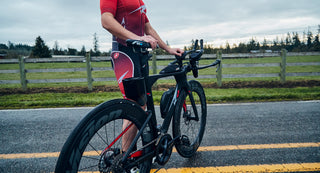Whether you’re an experienced triathlete or just beginning your tri journey, everyone has questions, right? With three sports comes three times the gear, and keeping everything straight can get complicated.
We asked some of our A2 athletes what topics they wanted to learn more about, and today we’re tackling the question - “What the heck is the right tire pressure to run on the road?”
Why is tire pressure important?
Tire pressure – measured in “psi” or pounds per square inch – is one of the most important factors to consider when preparing your bike for the road.

The correct tire pressure can increase your speed (by decreasing rolling resistance), provide better traction and control, reduce the risk of punctures or blowouts, and provide a more comfortable ride on different surfaces and weather conditions.
Too low? You risk pinch flats and slow times. Too high? You probably won’t have much fun bouncing over road bumps and could be a slicker ride in the rain. So what’s the best pressure for you? We break down why this changes person-to-person, depending on the weather, and which tires you’re running.
One thing to note: tire pressure is also incredibly important for off-road riding. For this blog, we’ll just be focusing on situations you may experience on road tires.
Factors that affect tire pressure
Several factors can affect the correct tire pressure for your bike. These include:
- Rider weight: A heavier rider will need more air in the tires to support weight and increased compression.
- Tire type: What width is your tire? Wider tires generally require lower pressures than narrower ones. Additionally, tire material can play a role in deciding what psi to run. Winter tires (like the ones many of us run in Portland during our rainy season!) may need less pressure than summer tires because of material thickness. If you do change tires with the seasons, make sure to pay attention to suggestions from the manufacturer (we’ll get to this again in a bit).
- Riding surface: A rougher surface may require lower pressure to absorb shocks, create a more comfortable ride (bracing against bumps takes a lot of energy!) and provide better traction. But too low could put you at risk for pinch flats (when the tube punctures against the rim of the wheel).
- Weather conditions: In rainy weather, you may want to run slightly lower pressure for similar reasons as above – even a 5psi decrease could allow more tire surface area to grip the road and avoid slipping.
- Tubes or tubeless: If your wheels are tubeless, you don’t have to worry about a tube getting pinch flats and can run a lower pressure if needed! This can be particularly helpful if you’re doing a course that might venture into a bit of gravel or rough road.
How to determine the correct tire pressure
Determining the correct tire pressure depends both on the manufacturer of the tire and the changing factors that we mentioned above.
 The general rule of thumb is to inflate your tires to the recommended pressure range printed on the sidewall of the tire and then adjust from there. The manufacturer will list a minimum psi – so that you aren’t risking rim damage or pesky pinch flats – and maximum psi, and then it’s up to you to do a bit of experimenting to figure out where your optimal pressure falls in this range.
The general rule of thumb is to inflate your tires to the recommended pressure range printed on the sidewall of the tire and then adjust from there. The manufacturer will list a minimum psi – so that you aren’t risking rim damage or pesky pinch flats – and maximum psi, and then it’s up to you to do a bit of experimenting to figure out where your optimal pressure falls in this range.
And don’t forget to check your tire pressure before EVERY ride.
Final Thoughts
Choosing the correct tire pressure can greatly improve your cycling experience. By inflating your tires to the recommended range and adjusting based on your experience and current conditions, you can ensure a smooth and efficient ride during your next ride or race.


